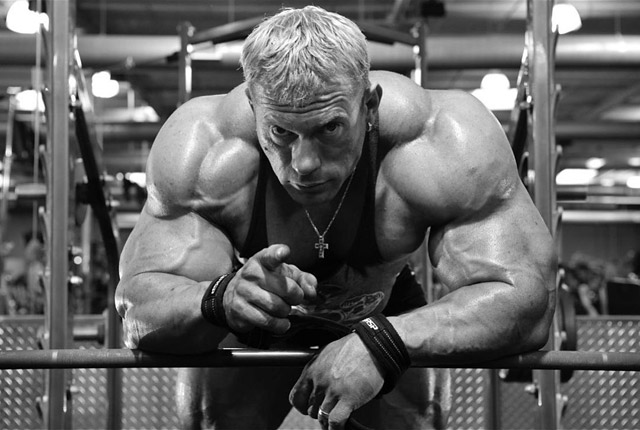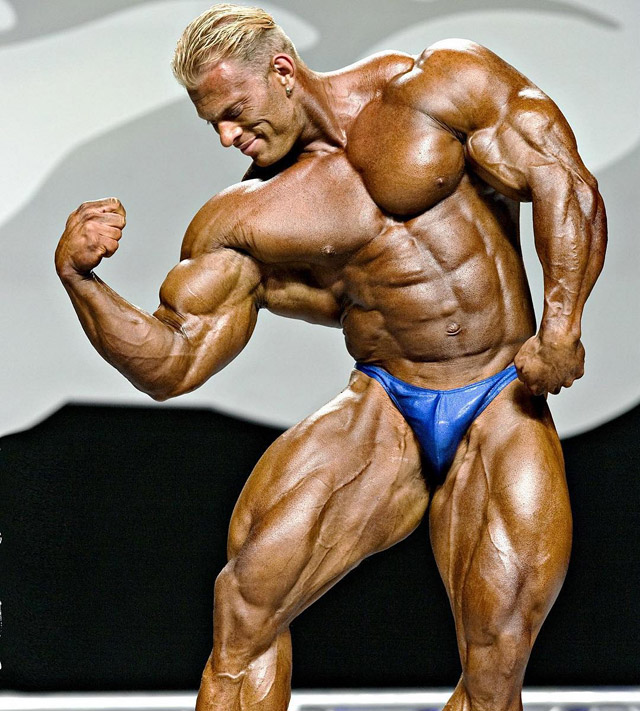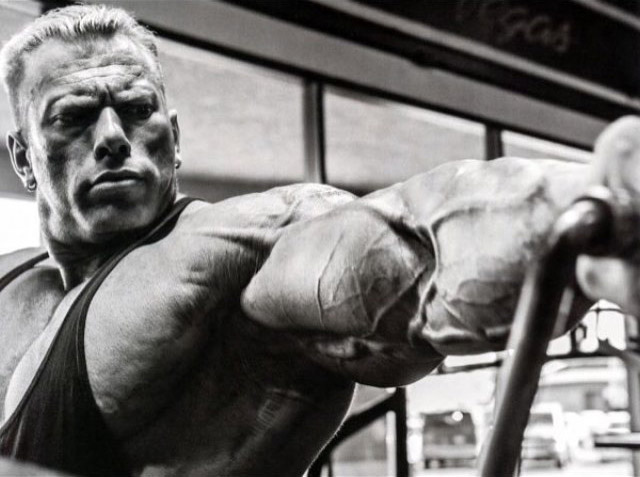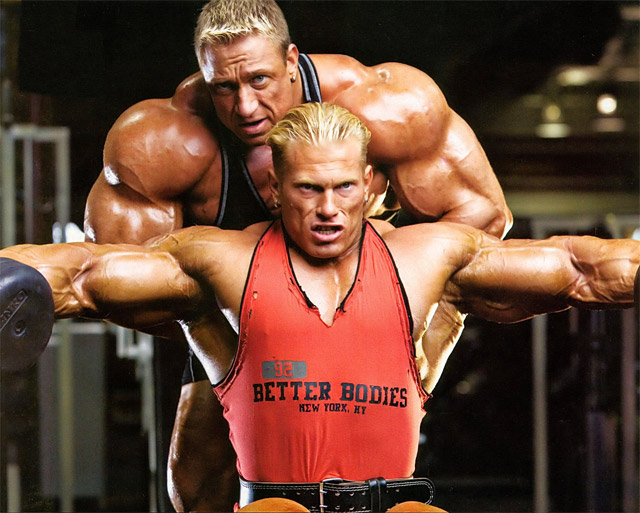To few bodybuilders in history, his fans placed greater hopes of winning the Mr. Olympia than to Dennis Wolf. It is no coincidence, then, that in addition to his usual nickname, “Big Bad Wolf,” he was often referred to as “Mr. Potential.” Before we focus on his training and tips for the development of pectoral muscles, it certainly does not hurt to recall his extraordinary career as a professional bodybuilder. 10 participations in the highest professional competition Mr. Olympia in the years 2006 to 2015 and most of the placement in the top six, so it is the balance that ranks him in the set of the best bodybuilders, who, however, never won the title of Mr. Olympia. Never? Is it possible to write it off completely at the age of 42? After all, so far his last competition performance dates back to a very recent time, ie to 2018, when 12. a place at the Arnold Classic may have completely demotivated him. Apparently, after cervical spine surgery in 2016, he was unable to return to his excellent form from the previous year (fourth at Mr. Olympia). Never say never, of course this may apply to Dennis Wolf, but I think when it comes to his successful comeback, we’re moving on a level of desire rather than reality. But even if he never stands on the competition boards, the overview of his famous successes puts him at the very top of German bodybuilders.
German? If we look a little closer to his career, we find that he was born in 1978 in the former Soviet Union, specifically in Kyrgyzstan, but to parents with German roots. He had no idea about bodybuilding as a boy, but for several years he played basketball quite successfully. In 1992, after the collapse of the Soviet Union, he moved with his parents and younger brother (the third brother was born in 1996) to the country of his ancestors, ie to Germany, to the city of Marl. “I didn’t know a word of German, but I had to learn this language very quickly, so I didn’t do badly at school with this language handicap either. I liked martial arts like Thai boxing and kickboxing at the time,” he describes his beginnings in his new homeland. Dennis.
He did not come from any intellectual family (father a worker and mother in the household), so no one forced him to continue his studies after high school. He took a job and worked as a room painter from nine to five in the evening. And at that time, at the age of nineteen, he became interested in bodybuilding, and his motivation was none other than Arnold Schwarzenegger. Although we speak of him as a genetic talent, his starting 73.5 kg to a height of 180 cm did not indicate anything like that. However, he improved very quickly and in 1999 he took the podium for the first time with 92 kg at the North Rhine-Westphalia Championship. And immediately he finished second. It gradually improved and the results corresponded to that. Apparently, he did not concentrate exclusively on bodybuilding at the time, because he managed to get married in 2003, and at the same time he married his wife Katja and his daughter Sabina from her previous marriage.
Only now did he hang a paintbrush on his nail and switch to professionalism. Become a professional? This was far from as easy then as it is now, when there are a number of qualifying competitions that make it possible, and rather it seems that it is only a matter of time and patience when the individual succeeds… At that time it was an exclusive company of the best the best. Only the winners of the World and Continental Championships could transform amateur status into a professional career. However, the absolute world champion could also take advantage of the unique opportunity to stand on the podium of Mr. Olympia without any qualifications, and of course Dennis took advantage of that. A competition where you just stand on the podium with the best pros is in itself a dream of everyone who is serious about bodybuilding. However, it has one disadvantage, for the first time, it’s really just about participating, and it was no different in his case. He paid a rookie tax and did not get into the top 16…
However, he made up for it in the highest level the following year on September 29 at the Orleans Arena in Las Vegas, when he took care of the biggest surprise of Olympia Weekend. Columnist magazine Muscle & Fitness Michael Berg reviewed his speech with these words: “With the amount of dense muscles, spread over an impressive skeletal structure, which gives it an almost classical proportions, suddenly becomes the darling of the audience, to the displeasure (would like to have it seen above) ends at According to a large number of experts on the professional scene, who find the future of competitive bodybuilding in the well-built Wolf, this is certainly an excellent result. “There is probably nothing to add to that, perhaps just the fact that from an unknown racer, he immediately became one of the favorites of the next Olympia. And Dennis turned those paper assumptions into reality, and in 2008 he moved up a rung. Paradoxically, he himself was not satisfied with his form and he lacked the necessary muscle hardness, especially in the final.

But the ice shower was yet to come. Mr. Olympia 2009 is one of his nightmares. At the same time, the preparation went exactly according to his ideas, but the final dietary error pushed him into the role of an outsider. Result? He didn’t even make it into the top fifteen… As he says: ” I didn’t lose to my opponents, but to myself because I wasn’t ready.” Anyone would mentally put such a shocking fall, but not so much Denise, because in his nature, Russian vigor and German consistency are combined. And so he immediately set about preparing for the next Olympia, where he naturally wanted to make up for a humiliating defeat. And most importantly, he did not want to disappoint his numerous fans, who saw in him a bright future of professional bodybuilding, a man who could perfectly present our sport to the general public.
The repair was successful, as evidenced by the return in the form of fifth place to Mr. Olympia 2010, and never left the final six in the annual participation in this competition until 2015. Third place in 2013 behind the winning Phil Heath and Kai Green was the culmination of his career. It is not the purpose of this article to analyze all of his participation in the Mr. Olympia, or rather its other results, but it should be remembered that even though he never managed to take over the statue of Sandow, he can of course boast a number of victories in professional competitions. Among them, we must name two triumphs at EVLS Praque Pro in 2012 and 2014. That is why it is especially close to our bodybuilding fans.
As the title of the article suggests, I would like to acquaint you with his training of the pectoral muscles, especially how this training developed over time and what principles he followed. Last but not least, we will present his training tips, which he recommends to follow. Dennis Wolf has managed to improve his pectoral muscles enormously since his professional debut in 2006, so it will certainly be interesting how he did it.
When Denis started training, he had no idea how to proceed. He watched the others and copied their training sessions. “In the first six months, I did a lot of one-handed stretching, pulling the counter rollers, and put some pressure on the machine because I thought that was the right thing for a beginner.” Denis describes his beginnings. Over time, gaining experience began to include pressure exercises on both straight and inclined benches, as well as upside down, while continuing with stretching exercises, but also at other angles than just on a straight bench. This transition to the predominant use of dumbbells was reflected in the improvement of the pectoral muscles during the year, especially in terms of their fullness and density. He confirmed the fact that for optimal results he has to work with both a large barbell and one-handed arms

He soon became convinced that the training of others can only be copied to a certain level of performance, and then every bodybuilder has to literally fit his training to his conditions and requirements. Everyone must find the exercises that bring them the best results, and to achieve them choose the necessary frequency, volume and sequence of exercises. For many years, he included pressure exercises mainly with a large barbell and on multipress, because the general opinion prevailed that these exercises are the most productive for the growth of muscle mass. However, Dennis had a problem with the shoulders taking over much of the muscle work during the high-barbell pressure exercises. “So I reoriented myself to using one-handed, and I only had one fourth workout with a great barbell. It’s about isolating my pectoral muscles as much as possible and feeling how they work, and one-handed was key to that,” Dennis explains.
Another effective procedure that Dennis used to develop his breasts was to constantly change his training. You would have to look at 20 or 30 of his workouts to find two that are identical. He acknowledges that there are bodybuilders who do not change their training, and yet it brings them lasting results, but he is not one of them and necessarily needs constant change. So what was the arsenal of his “weapons” that he used most often? Let’s take a closer look.
Pressures with one-handed dumbbells
75 percent of his workouts start with one-handed pressures. What it doesn’t change, because it still works well, is the alternation of single-arm pressures on a straight and inclined bench. It was the one-handed dumbbells that for many years was the means of preventing his dominant deltoid muscles from taking over the pectoral muscles. “I can’t use as many heavy weights with one arm as I do with a big barbell, but that doesn’t matter. I used to focus on heavy weights and wanted to lift as much as possible, but once I left this approach, the pectoral muscles grew much better.”Dennis clarifies his training philosophy. These thoughts should be taken to heart by those practitioners who are literally obsessed with heavy weights. At single-arm pressures, Dennis lifts the dumbbells in parallel directly above each other and does not try to push them together, because in such an embodiment, the front deltas work more. It’s his experience, which of course may not apply to everyone.
Bench press
He placed the pressures with a large barbell with success for 15 years, but now rarely. He got into a situation where he did not do bench-press more often than once a month. Even with this purely strength exercise, he did not focus on the use of large weights, but on the perfect technique of execution. “I contract the pectoral muscles as much as possible when lifting the barbell, and on the contrary, I stretch the muscles as much as possible when lowering it.” Although he doesn’t use bench-press often, he recommends it to all beginning bodybuilders, because he is the king of all chest exercises. In the case of mid-level bodybuilders, Dennis advises them to use heavy weights, but again provided perfect technique and maximum stretching in the lower phase of the movement.
Pressures on the Hammer Strength machine
He did not classify machines of this type before, but later changed his mind. “Hammer Strength push-ups on a sloping bench are a very valuable exercise for me because they target my upper chest precisely, giving them the mass and massiveness they need,” says Dennis. So he really liked the exercises on this machine and classifies them, although his first exercise is in most cases pressures on a sloping bench with one arms. It also includes exercises on other types of Hammer Strength that target a different area of the breast, for example when it needs to improve the outer or lower area of the pectoral muscles.
Removal of opposite pulleys
Stretching on a straight or inclined bench supports the growth of the pectoral muscles in a different way than pressures and helps to develop and fill the outer and inner area. But sometimes Wolf doesn’t include any spreads and goes to the pulley tower to the opposite pulleys. He makes three different variants and sometimes only one series in each variant is enough. In one variant, it leans forward deeply, in the other it stands completely upright, and in the third, in an upright position, it pulls the pulleys perpendicular to the torso in front of the chest. These three variants perfectly train all parts of the pectoral muscles. However, both when tightening and when lowering the counter rollers, it warns against cheating, which is usually again caused by the use of too heavy weights. Do not bend your arms too much at the elbows, in these cases these stretching exercises acquire the character of pressure exercises! That is his warning.
Everyone who needs to gain more pectoral muscle volume is advised to devote as much time and energy as possible to basic exercises, such as pressure and push-ups on parallel bars (or similar variants). In his opinion, many beginners are literally wasting time overusing the pulling of the counter rollers, which is an excellent exercise for working out the details of the pectoral muscles, but not for their volume and density.
| exercise | series | repetition |
|---|---|---|
| bench-press | 2 | 18 – 20 |
| bench-press | 4 | 10 – 12 |
| stretching on a straight bench | 3 | 12 – 14 |
| oblique pressures on the Hammer Strength machine | 4 | 12 |
| pullovers with one arm perpendicular to the bench | 4 | 12 |
| cranks on the machine (on the bars) | 4 | 10 – 12 |
How to include breast muscle training in the training program?
Dennis Wolf recommends placing pectoral muscle training in the first place of the training program and combining their training with biceps or triceps. Another option is to train them completely independently. He does not consider it appropriate to combine this training with the shoulders. The pressure exercises for both parts are similar and in both cases the triceps are strongly involved as an auxiliary muscle. If the pectoral muscles are among your weaker muscle parts, it is advisable to include their training after one or two days of rest, so that you have as much energy and strength as possible for their thorough exercise.
Common mistakes in breast training
1) You do not focus your efforts on your weaknesses
It depends on your genetic predisposition, whether the upper or lower area of the breast responds better to training. However, most of us have a worse development in the upper area. Carefully and critically evaluate the development of your pectoral muscles and set priorities accordingly,
2) Still the same training
This applies to every muscle part! Many exercisers perform constant training with the same weights month after month, throughout the year, and even more. And of course, thanks to that, it still looks the same! Your muscles will get used to the same training over and over again, and due to this stereotype, you are no longer making any progress. So you have to make changes, when choosing exercises, their order, but also the number of repetitions.
3) Lack of connection between the brain and muscles
This point also applies to all muscle areas, but Dennis sees a problem especially with the pectoral muscles. Many exercisers are so proud of the size of the weights they use and want to impress everyone else in the gym that they train as weightlifters, not as bodybuilders. But with each repetition, you have to perceive how the pectoral muscles contract and then stretch. You have to feel how the muscles work and at the same time how they blood. If not, you are doing something wrong. So don’t be ashamed to reduce the load if you feel that this way the muscles work better!

Dennis Wolf’s tips for developing stronger pectoral muscles
1) Start training with free weights
Free loads, ie exercises with dumbbells, are demanding on maintaining balance and the ability to coordinate movement, and both of these properties deteriorate as training progresses and with the onset of fatigue. Therefore, always start training with exercises with a large barbell and one-arms, and include exercises on machines or pulleys in the second half of the training or at the end.
2) Forget about your ego
The bodybuilder presents himself with his figure, not the weights he lifts. Therefore, use loads with which you are able to perform the exercise technically clean, otherwise your results will be unsatisfactory, and you may be injured.
3) Practice with a sparring partner
It is indispensable for heavy pressures with a large barbell, both on a straight and inclined bench. With the help of a series, you can go to the limit of exhaustion in the series, without having to worry that you will fail and fail the barbell.
4) Include posing and stretching
Instead of resting passively between sets, stretch the trained muscles in the poses to the appropriate muscle part, and then stretch them. This will improve the connection between the muscles and the brain, but also the details of muscle development, separation and outlining. And it only takes a few seconds.

